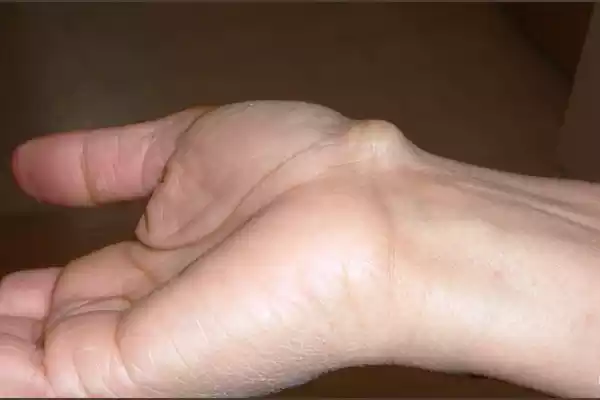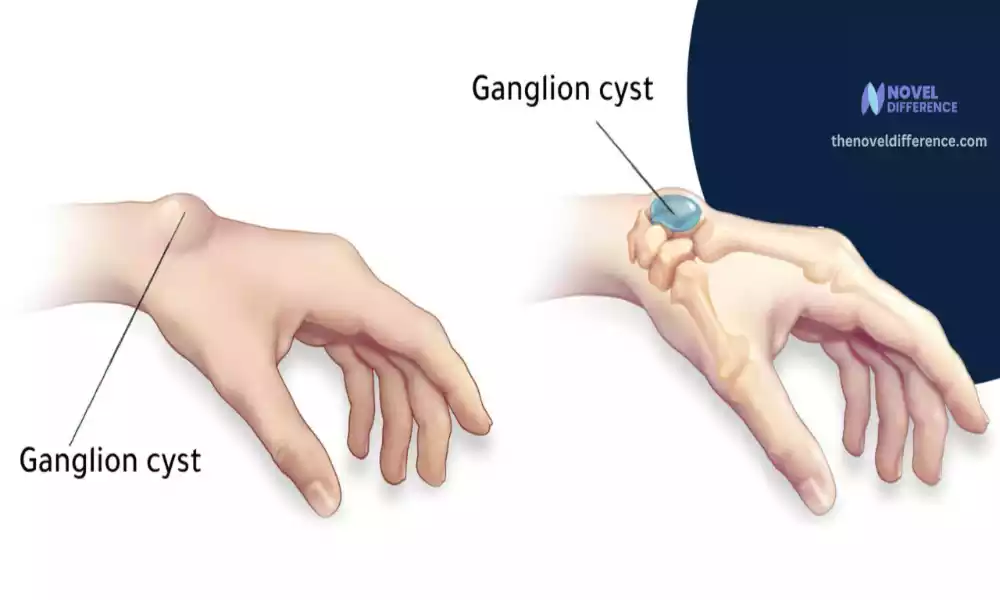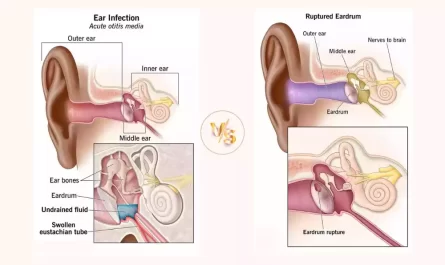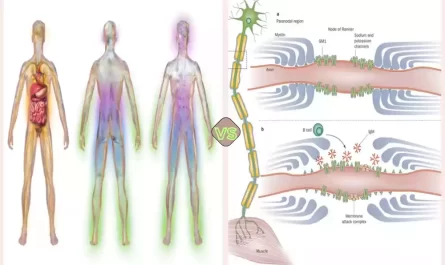Introduction of Carpal Boss and Ganglion Cyst
Hand and wrist ailments can often be perplexing, and two conditions that frequently lead to confusion are Carpal Boss and Ganglion Cyst. Though they share some similarities, they are distinct in their nature, causes, and treatments.
This brief overview will introduce these conditions, setting the stage for a deeper exploration of their differences and management. Understanding these distinctions is crucial for those experiencing hand or wrist discomfort, as it guides proper diagnosis and effective care.
What is Carpal Boss?
Carpal Boss, medically known as “Carpal Bossing” or “Carpal Boss Syndrome,” is a distinctive condition characterized by the presence of a bony lump or prominent area on the dorsal (back) aspect of the hand. This lump typically forms at the base of the second or third metacarpal bones, which are the long bones in the hand that connect the fingers to the wrist.

Key characteristics of Carpal Boss include:
- Bony Growth: Carpal Boss is primarily characterized by the development of excess bone, resulting in a noticeable lump or bump on the back of the hand.
- Location: It most commonly occurs at the junction of the second and third metacarpal bones, although it can occasionally affect other areas of the hand.
- Pain and Discomfort: Many individuals with Carpal Boss experience pain, tenderness, or discomfort at the site of the bony prominence. This pain can be aggravated by certain hand movements or activities.
- Causes: Carpal Boss is often associated with repetitive stress or trauma to the hand. It can also be linked to genetic factors and certain occupational activities that place strain on the hand.
- Diagnosis: Diagnosis typically involves a physical examination by a healthcare professional and may be confirmed through imaging tests such as X-rays or MRI scans.
- Treatment: Treatment options for Carpal Boss vary depending on the severity of symptoms. Conservative measures may include rest, activity modification, and splinting. In more severe cases or when conservative treatments fail, surgical interventions such as excision or fusion may be considered.
Carpal Boss can vary in size and may be more prominent in some individuals than in others. While it is not a life-threatening condition, it can cause discomfort and impact hand function. Therefore, individuals experiencing symptoms should seek medical evaluation to determine the most appropriate treatment approach.
Prognosis and recovery
The prognosis and recovery for Carpal Boss can vary depending on several factors, including the severity of the condition, the chosen treatment approach, and individual factors.
Here’s a general overview of what to expect regarding prognosis and recovery:
- Conservative Treatment:
- For mild cases of Carpal Boss, conservative treatments such as rest, activity modification, and the use of a splint or brace are often effective in managing symptoms.
- The prognosis with conservative treatment is generally favorable. Many individuals experience relief from pain and discomfort and can return to their regular activities with time and appropriate care.
- Recovery may take a few weeks to several months, depending on the extent of symptoms and the individual’s response to treatment.
- Surgical Treatment:
- In cases where conservative treatments fail to provide relief or when the Carpal Boss is causing significant pain and functional impairment, surgical intervention may be recommended.
- Surgical procedures for Carpal Boss can include excision (removal of the bony prominence) or fusion (joining the bones to prevent movement).
- Prognosis after surgery is typically positive, with many individuals experiencing a reduction in symptoms and improved hand function.
- Recovery after surgery may involve a period of immobilization and physical therapy to regain strength and range of motion in the hand.
- Full recovery after surgery may take several months, and the timeline can vary based on the specific surgical approach used and individual healing rates.
- Complications:
- While complications from Carpal Boss surgery are relatively rare, there can be risks such as infection, scarring, or persistent discomfort.
- It’s essential for individuals to follow their surgeon’s post-operative instructions carefully and attend follow-up appointments to monitor the healing process and address any concerns promptly.
- Long-Term Outlook:
- After successful treatment, many individuals with Carpal Boss can expect a good long-term outcome with minimal or no symptoms.
- However, it’s important to note that Carpal Boss can sometimes recur, especially if the underlying causes, such as repetitive hand stress, are not addressed.
- Ongoing hand care, ergonomic adjustments, and protective measures may be necessary to prevent recurrence in some cases.
The prognosis and recovery for Carpal Boss depend on individual factors, the effectiveness of the chosen treatment, and the dedication to post-treatment rehabilitation. Consulting with a hand specialist or orthopedic surgeon is crucial for proper evaluation, treatment planning, and guidance throughout the recovery process.
What is Ganglion Cyst?
A Ganglion Cyst, often referred to simply as a “ganglion,” is a common non-cancerous lump or cyst-like mass that typically forms near joints or tendons, most commonly in the hand and wrist. These cysts are filled with a thick, jelly-like fluid and are often painless, but they can cause discomfort or become cosmetically bothersome.

Here are the key characteristics and details regarding Ganglion Cysts:
- Appearance and Feel:
- Ganglion Cysts appear as soft, round, or oval lumps beneath the skin’s surface.
- They are often firm or rubbery to the touch and may be movable.
- Ganglions can vary in size, from small pea-sized cysts to larger, more noticeable lumps.
- Location:
- Ganglion Cysts most commonly occur near joints and tendons in the hand and wrist. They can also develop in the ankle, foot, knee, or other joints in the body.
- Fluid-Filled Sac:
- These cysts contain a thick, clear, or slightly opaque synovial fluid, which is the lubricating fluid that normally surrounds joints and tendons.
- Causes and Risk Factors:
- The exact cause of Ganglion Cysts is not always clear, but they are often associated with joint or tendon irritation or injury.
- Repetitive microtrauma or overuse of a joint may contribute to its formation.
- Women, particularly those between the ages of 20 and 40, are more commonly affected.
- Symptoms:
- Many Ganglion Cysts are asymptomatic and are discovered incidentally.
- Some individuals may experience pain or discomfort, especially if the cyst presses on a nerve or tendon.
- Ganglions can change in size over time, sometimes getting larger or smaller on their own.
- Diagnosis:
- Diagnosis typically involves a physical examination by a healthcare provider.
- In some cases, an ultrasound or MRI may be used to confirm the diagnosis or assess the cyst’s location and size.
- Treatment Options:
- Treatment may not be necessary if the cyst is small, painless, and not causing functional impairment.
- Watchful waiting is an option, as some ganglions may resolve on their own.
- Aspiration involves draining the cyst’s fluid with a needle, which can provide temporary relief.
- Surgical removal (excision) may be recommended if the cyst is painful, cosmetically bothersome, or causing functional limitations.
- Recurrence:
- Ganglion Cysts may occasionally return after aspiration or surgical removal.
It’s important to note that while Ganglion Cysts are usually benign, any new lump or bump should be evaluated by a healthcare professional to rule out other potential causes. The decision to treat a Ganglion Cyst is often based on the individual’s symptoms, the cyst’s location, and its impact on daily life.
Treatment options
Treatment options for Ganglion Cysts include:
- Watchful Waiting: If the cyst is small and painless, monitoring its progress over time may be recommended.
- Aspiration: Draining the cyst’s fluid with a needle can provide temporary relief but may lead to recurrence.
- Surgical Excision: Surgical removal of the cyst is considered for larger, painful, or bothersome cysts. It has a lower recurrence rate than aspiration.
- Immobilization and Physical Therapy: After surgery or aspiration, immobilization and physical therapy may aid recovery.
- Corticosteroid Injection (Less Common): Injections may be used to reduce inflammation and pain.
Consulting with a healthcare provider is crucial to determine the most suitable treatment based on individual factors and symptoms.
Carpal Boss and Ganglion Cyst in the comparative chart
Here’s a comparative chart highlighting the key differences and similarities between Carpal Boss and Ganglion Cyst:
| Characteristic | Carpal Boss | Ganglion Cyst |
|---|---|---|
| Location | Dorsal aspect of the hand | Near joints or tendons in the hand or wrist |
| Composition | Bony growth or lump | Fluid-filled cyst |
| Causes | Repetitive stress, trauma, genetic factors | The exact cause is often unknown, joint or tendon irritation is possible |
| Symptoms | Pain, discomfort, tenderness | Often painless but can cause discomfort or pain if pressing on nerves |
| Diagnosis | Physical examination, imaging (X-rays, MRI) | Physical examination, sometimes ultrasound |
| Treatment Options | Conservative (rest, splinting), surgery | Watchful waiting, aspiration, surgery, corticosteroid injection |
| Recurrence Rate | Low to moderate | Moderate to high |
| Prognosis | Favorable with appropriate treatment | Favorable with or without treatment |
| Complications | Surgical risks, recurrence | Recurrence after aspiration, surgery risks |
| Prevalence | Less common | More common |
Remember that while this chart provides a general comparison, individual cases may vary, and proper diagnosis and treatment should always be determined by a healthcare professional.
Similarities Between Carpal Boss and Ganglion Cyst
Here are some of the key similarities between Carpal Boss and Ganglion Cyst:
- Hand and Wrist Location: Both Carpal Boss and Ganglion cysts commonly affect the hand and wrist, though they appear in different regions.
- Pain and Discomfort: Both conditions can cause pain and discomfort in the affected area, although the severity may vary.
- Diagnosis Methods: Diagnosis for both conditions often involves physical examination by a healthcare provider and may include imaging tests like X-rays or ultrasound.
- Surgical Treatment: Surgical intervention is an option for both Carpal Boss and Ganglion Cysts when conservative treatments are not effective or symptoms are severe.
- Potential for Recurrence: Both conditions can potentially recur even after treatment, although the recurrence rates may differ.
While these similarities exist, it’s crucial to recognize their differences to ensure accurate diagnosis and appropriate treatment. Consulting with a healthcare professional is essential for proper evaluation and guidance.
Conclusion
Carpal Boss and Ganglion Cyst, while both affecting the hand and wrist, are distinct conditions with unique characteristics. Carpal Boss involves a bony lump and is often caused by repetitive stress, while Ganglion Cyst is a fluid-filled sac near joints or tendons, with an unclear cause.
Proper diagnosis and treatment are essential, as both conditions can cause discomfort and have a risk of recurrence. Consulting a healthcare professional for evaluation and guidance is crucial for effective management.




